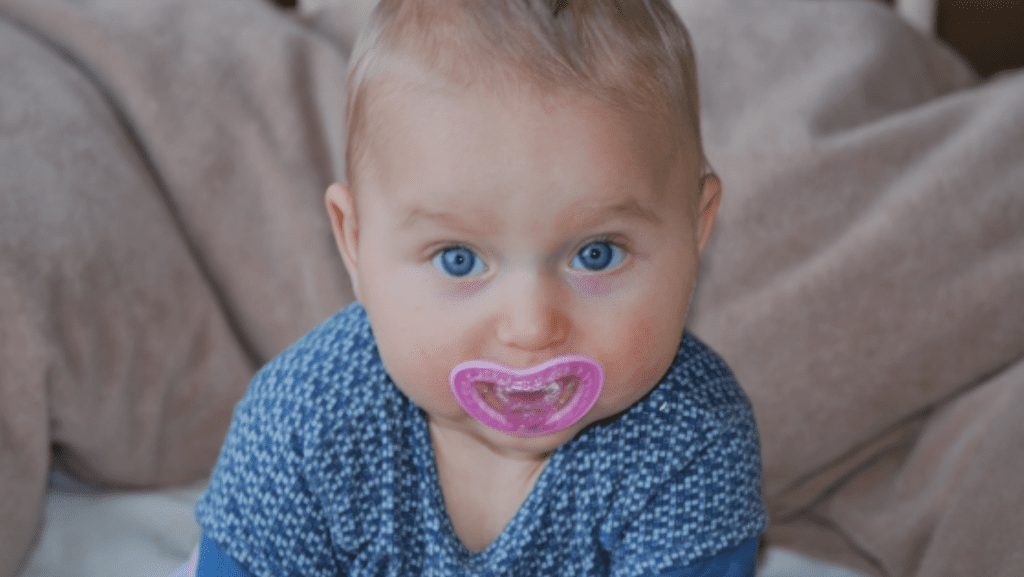
Are you dreading ditching the dummy? Whether you always planned to give your baby a dummy/pacifier/soother, or you made a 2am dash to the 24-hour supermarket, you will eventually want to stop it. Many parents dread the day, or simply don’t know how to go about this. I can’t promise it will be easy, but here are some tips.
Did you start using a dummy because your baby was unsettled? Did they have colic? Did you have oversupply and so comfort suckling was a bad idea?! Was your baby in the NICU? Did you decide you’d rather your baby had a dummy than sucked their thumb? Did you move from bottle to breast or use a nipple shield? There are SO many reasons why you may have started. Whether your little one is now 6 months, 8 months, 2years or about to start school, you’ll have your own reasons for ditching the dummy.
Ditching the dummy – why?
You may already have some ideas about why you want to stop your child relying on their dummy/paci. Do you feel they are too old for it? Is it beginning to affect their speech? Is your breastmilk supply taking a hit? Are people staring?! Or are they waking up every 30 minutes because their dummy has fallen out? Yikes! Both choosing to start using a dummy and choosing when to stop using it are intensely personal decisions. I’m not here to judge any of them. Nor am I suggesting that there is a standard right time for ditching the dummy. That may be different for everyone.
Ditching the dummy – when?
This is a tricky one. Most people aren’t interested in dummy ditching before 6 months. In general, if a young baby has a dummy, most people find that this is not problematic. But many parents find that things start to get real when their baby is around 7-10 months. At this age it can become an attachment object and cause more problems with sleep than it solves. However, because this is also a time of huge developmental change, it can therefore be a difficult time to remove the dummy. You may have a child who is waking more at night anyway, due to huge changes in their cognitive, physical and emotional development (read more about sleep ‘regressions‘ here).
So, although this may be the age when the dummy is causing the most problems, it may also be the age at which it is the hardest to address (at least without a lot of tears anyway). You have a few options:
- Ride it out and wait until your little one seems more settled
- Put lots of dummies in their cot/crib and hope they can find one
- Attempt to get rid of the dummy, but accept that it will take time, persistence and patience
As a child gets older, they sometimes spontaneously develop the ability to either find their dummy on their own, or if you wait long enough, you may be able to negotiate with them.
Ditching the dummy – how?
So, if you’ve decided that the time is right, you may want to consider whether you do this ‘cold turkey’ or gradually. There are a few options you could think about.
- First of all, only try removing a dummy when your child is well. A baby or toddler with a heavy cold, earache, or cutting teeth is not going to be impressed with having their dummy removed. Also avoid doing this when there is something stressful going on – such as a house move, starting nursery/daycare, or the imminent arrival of a new sibling.
- Start by working on the easiest nap of the day. This is often the first nap, but if that’s not how your little one rolls, then try at the best time for them. If you want to try this very gently, consider taking the dummy out just as they are falling asleep. You’ll probably need to pat or reassure your baby, and they may startle a bit. If it’s a real disaster, then try again at the next nap, or the next day.
- Once you have one nap going well, move on to the rest of the day’s naps (if applicable), followed by bedtime.
- You could try overlapping some new sleep cues at the same time as your little one falls asleep – such as a comforter, some soothing music or white noise/nature sounds, and a scent in the air (more tips here) which may make it easier for your baby to accept ditching the dummy
- Tackle the nights last of all – as they are hard on everyone!
Some children don’t respond well to a gradual removal of a dummy. In this case, the kindest thing to do is probably to remove the dummy and replace with cuddles and reassurance and be prepared for 3-5 rough nights. Change is hard for little ones!
However you go about your dummy situation, remaining calm, reassuring, patient and emotionally available is crucial. Children are masters at picking up on our anxiety, so you’ll need to prepare yourself mentally (more tips here). Be consistent and persistent and you’ll get there.
Good luck!
Lyndsey Hookway is a paediatric nurse, health visitor, IBCLC, holistic sleep coach, PhD researcher, international speaker and author of 3 books. Lyndsey is also the Co-founder and Clinical Director of the Holistic Sleep Coaching Program, co-founder of the Thought Rebellion, and founder of the Breastfeeding the Brave project. Check Lyndsey’s speaker bio and talk brochure, as well as book her to speak at your event by visiting this page. All Lyndsey’s books, digital guides, courses and webinars can be purchased here, and you can also sign up for her free monthly newsletter here.
